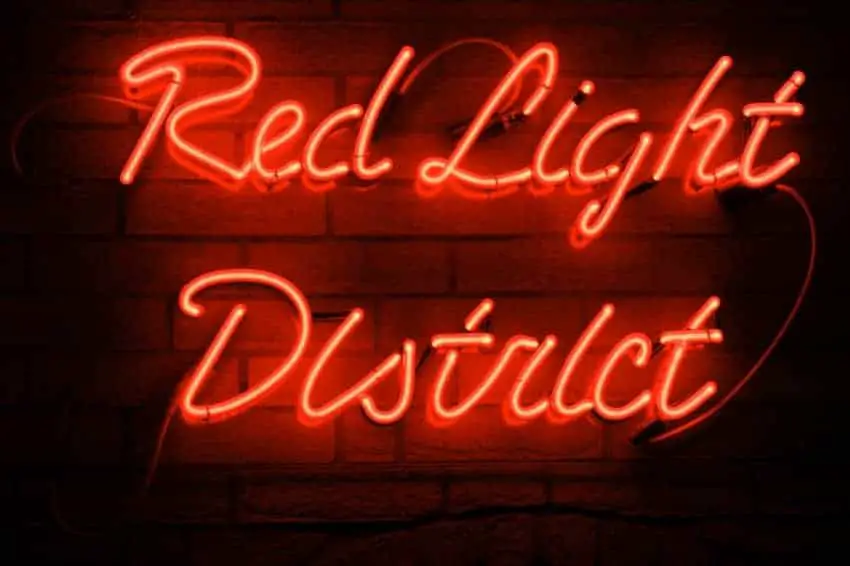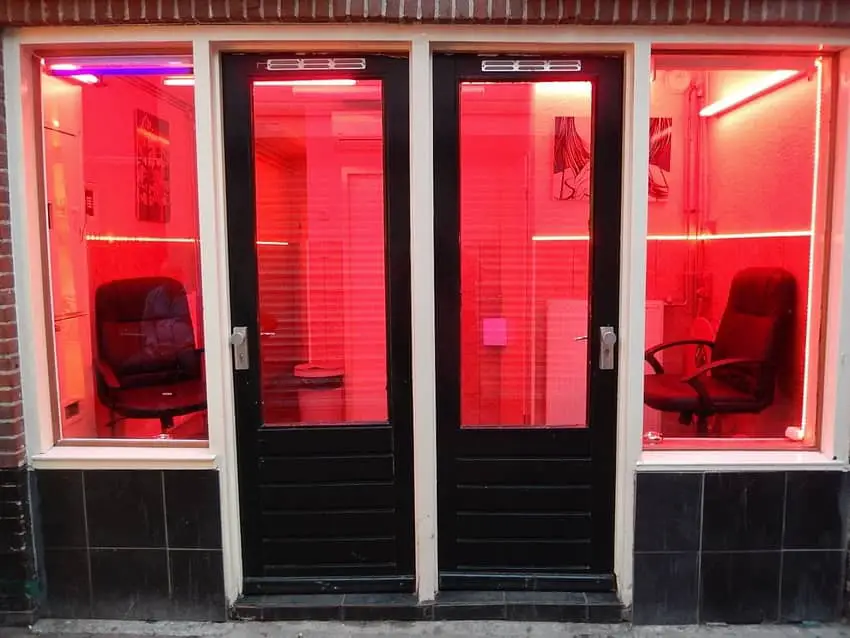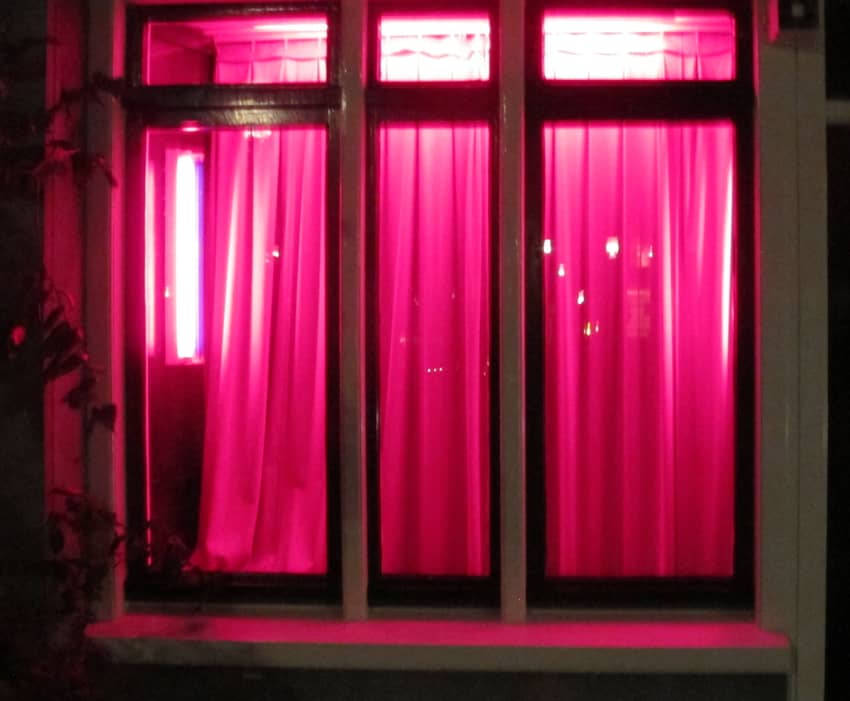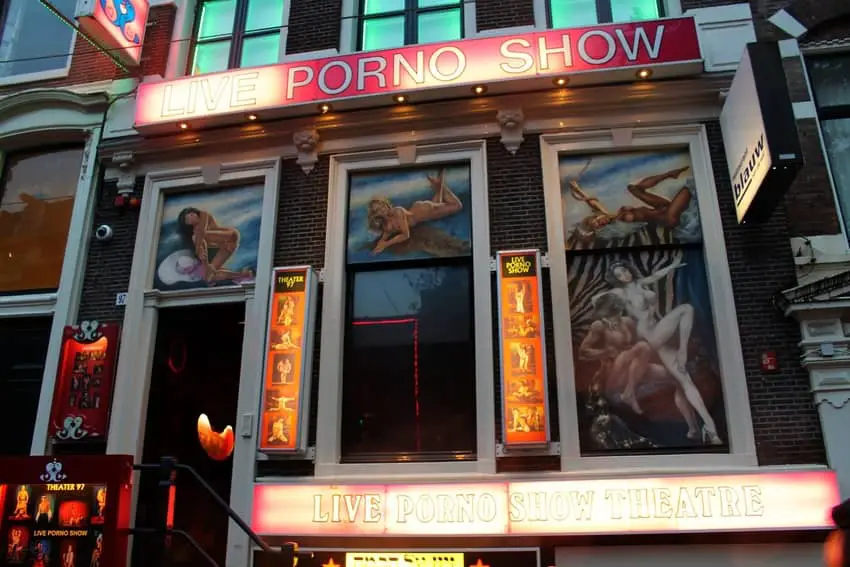From sex windows and brothels, through sex shops to sex museums, Amsterdam’s Red Light District has it all. It’s probably one of the most popular (and most talked-about) areas in the whole country. As Amsterdam is considered to be a cradle of the world’s oldest profession, many questions about the district arise. Leaving nothing to the imagination, I am presenting a comprehensive guide on the Amsterdam Red Light District. If you’re looking for the most important facts, here you go!

The History of Red Light District
The history of the area dates back to the 14th century. Back then, Amsterdam was one of Europe’s most important trade centers. The harbor was very close, there were many sailors – these are the main reasons why prostitution actually started. Amsterdam quickly became a magnet for the oldest profession in the world. When Dutch protestants overthrew the Catholic government, the district was transformed and immediately became the center of nightlife and entertainment (mainly for sailors and travelers). The area was one of the oldest in the city, located just perfectly to be considered a social center. Sailors were coming to the district to enjoy some drinks in taverns and spend time with girls. The industry blossomed.
Surprisingly, since medieval times until the year, 1810 prostitution was considered illegal and mainly was ‘underground’. Then, in 1810, Napoleon decided to make it legal with the condition that prostitutes were checked regularly for health. They were given a red card after a clean exam. In the 20th century, some restrictions on sex work were lifted by the Dutch government. In 1988 prostitution became a legal profession which meant that sex workers were granted the same rights as any other profession. Since then, they have had to declare their income and pay taxes. Brothels were legalized in 2000 and started operating as legitimate businesses.
What Changed After the Year 2000?
After brothels became legal in 2000, a great number of pimps, human traffickers and money launderers started to operate in the area. The city officials decided to start cleaning up the district in order to reduce the number of red-light windows. In 2007, the project 1012 was introduced. The name of the project came from the area’s postal code. The main idea behind the initiative was to encourage art galleries, cafes, enterprises and fashion studios to set up in the Red Light District. 6 years later the government decided to raise the minimum age for sex workers to 21. What’s more, new operating hours were set for red-light windows (they now have to close between 6 am and 8 am).

At the moment, there are over 300 sex windows out there, as well as several brothels and some sex stores and sex theatres. This year, new legislation on the Red Light District was introduced. The city instituted a ban on new tourist-oriented stores within the center of the city and regulated short-term housing better. Also, starting from 2020, there won’t be tours of Red Light District anymore.
Why Is Red Light District Called So?
Originally, the red light was a sign that a house of prostitution was open. If the light was turned off, that meant the house wasn’t operating at that very moment. Today, districts where prostitution is legal, still use red fluorescent lights. It doesn’t necessarily mean the venue is open anymore. However, because of the tradition, the red light district name is assigned to areas where prostitution is popular.

Interesting fact: in Dutch, the area is called ‘De Wallen’. It can be translated as ‘the walls’. For many, it’s only because some of the canals in the area (and next to the harbour) were walled off so that the river Amstel was prevented from flooding to the city. However, the name has also a less popular meaning – the word ‘wall’ used to be a code name for paid sex.
Where Is Red Light District Located?
Red Light District is located in the very center of the city, in walking distance from Amsterdam Central Station. This is of course the primary Red Light District area (as there are 3 areas in the city). The second one is situated between the Singel and Radhuisstraat, right next to the Dam Square. The third Red Light District area is located in the Pijp – right behind the Rijksmuseum.
What You’ll Find in the Red Light District Area
The main Red Light District area in Amsterdam consists of two canal streets and several side alleys. The heart of the area is formed by Oude Zijdsyoorburgwal and Oude Zijdsachterburgwal. The district doesn’t have an entrance or an exit. Even if the area is quite small, there are so many things out there! Bars, coffee shops, cannabis memorabilia, sex windows – you’ll find those everywhere you look. The area has no opening hours – it’s always freely accessible. However, if you want to use the services of a sex worker, you should be there before 4am – this is the time the sex windows start closing.

There’s no entrance fee, the whole area can be easily accessed. The sex workers set their own prices, usually based on clients wishes. Most people think that Red Light District is all about prostitution and coffee shops. However, this isn’t an entire truth. There are many cultural activities out there, as well as venues like clubs, sex theatres, peep shows, sex shops and typical Dutch brown cafes.
Cultural Activities
In the area, you’ll find some extremely interesting museums. First and foremost, the brothel-turned-sex work museum – Red Light Secrets. It gives visitors a behind-the-scenes insight into the sex worker’s profession. The similar venue is the Museum of Prostitution – there, you can even take the opportunity to stand behind a window yourself. There is also the Erotic Museum where you can, among the others, visit bondage exhibits. I also recommend that you should visit the famous Sexmuseum Amsterdam between Dam Square and Amsterdam Central Station. For those who want to dive deeply into the history of this place, there are many Museums to visit.

Adult Entertainment
Amsterdam’s Red Light District is for sure a place for those who aren’t easily offended. There are many sex shows (including the interactive ones) and peep shows. The most popular shows can be found at Amsterdam Banana Bar, Casa Rosso and Moulin Rouge. Red Light District is also home to many gay bars and cinemas. Brothels and private houses offer much more than what you call a traditional form of prostitution. There are also coffeeshops that actually exist all over the city. The most popular coffeeshops in Red Light District are Baba and Greenhouse.

Architecture
You might be surprised but Amsterdam Red Light District is also famous for its exceptional architecture. If you like historical buildings, Red Light District may be your lucky strike. For example, the oldest residence in the city is located on Warmoesstraat 90. Its façade was probably erected in 1485. The most popular building in the area is Oude Kerk, one of Amsterdam’s oldest churches. There are also the Amsterdam dungeon, the Rembrandt House and Madame Tussauds. You should also visit the narrowest street in the city – Trompettersteeg where you cannot even walk side by side! If you’re seeking for some beautiful views, stop by Oudezijds Armsteeg – the six Delft blue houses standing in a row are just jaw-dropping!

Drinking, Dining, Shopping
I must say, Red Light District has a wide variety of restaurants and pubs! Some useful info for the fans of Dutch jenever – there are many tasting houses out there. I also love the brown cafes (historic Dutch pubs) and breweries. You won’t find many elegant restaurants there. It’s quite the opposite – most of restaurants are fast foods serving frites and pancakes. There are also many automat windows with deep-fried snacks. When it comes to shopping, there are many weird shops, like… Condomerie Het Gulden Vlies. The venue sells condoms in all shapes, design, flavours and colours you could imagine.

Is Red Light District Safe?
Usually, places that sell prostitution/sex are considered to be dangerous. However, it’s quite the opposite when it comes to the Amsterdam Red Light District. In some way, the area is safe, even compared to similar areas in other cities/countries. Every night you can see numbers of tourists, couples, groups of students and even families walking around out there. The area is safe both day and nighttime. There are countless police officers that patrol the area. The only threat in the Red Light District is pickpocketing. The place is extremely crowded all the time, it’s easy to get distracted and pickpockets try to take their chances whenever possible. Thus, while in the Red Light District, make sure you keep a close eye on your personal belongings. It’s always reasonable to leave your passport etc. in a bag or in a safe in the hotel you’re staying at. Even in the middle of the day, make sure you keep your purse and wallet close to your body all the time. Also, make sure you follow the general rules on bicycles and drugs. If anyone offers you a bike or drugs, it’s always better to say no. Such goods are usually stolen. Remember: in case you’re caught, both the seller and the buyer are imposed high fines. In general, if anyone wants to sell you anything, the best decision is to decline their offer.
Prostitution in Red Light District
Amsterdam, and actually the Netherlands in general, is one of those places where people enjoy the honesty of life, instead of criminalizing everything. The Central Bureau of Statistics estimates that the industry generates around 650 million Euro per year. Currently, since 1810, prostitution has been legal in the Netherlands. Since 2000, window prostitutes have been allowed to legally offer their services. They have had to pay taxes and so on. They can use medical care at work and their work standards are regulated.
Prostitution is illegal on the streets though. Sex workers are not allowed to even promote their services on the streets of Red Light District. The law applies on the streets, next to the roads and in publicly accessible buildings. The fine for street prostitution is 115 Euro (both the sex worker and the customer pays the whole amount). In Amsterdam, there’s even the Prostitution Information Center. It’s a fount of information for both visitors and workers. The center runs informative walking tours twice a week (each takes around 90 minutes). You can also buy a self-guided tour at the shop for as little as 3 Euro.
The Red Light District Etiquette
There are some things you should do/don’t do in Amsterdam Red Light District, as well as some regulations to follow. When it comes to age restriction, the area is publicly accessible which means there is no age restriction there. However, for the shows, brothels, and shops, there is an age restriction – you have to be at least 18 to attend. Bear in mind that in Amsterdam, police in literally everywhere. In order to make sure you get most of the Red Light District and you don’t get in any trouble, here’s a short crib sheet.
| WHAT YOU SHOULD DO | WHAT YOU SHOULDN’T DO |
| Watch out pickpocketers – leave the most important things at the hotel | Don’t take any photos of the occupied windows |
| Be respectful to the neighbourhood | Don’t buy from dealers |
| Behave in the Red Light District area | Don’t drink alcohol on the street |
| Avoid any tours of the windows | Don’t tap on the windows and don’t stand too long in front of the windows |
Some more info about the abovementioned rules:
Keep in mind:
- pickpocketers: they are extremely common in crowded areas of Red Light District. This is why you should be prepared while wandering in the area. It’s better to leave the most valuable things at the hotel.
- behave! – There are people living in Red Light District. Try not to shout or sing on streets there. Also, don’t be one of those tourists who litter on the streets. Would you like people litter and shout all over your porch?
- As already mentioned in the article, tours of the windows are officially prohibited. It means that evening tours of the district will be illegal. If anyone offers you such a tour, you should definitely say no.
Don’ts
- taking photos is strongly prohibited. Any attempt is stamped out immediately. On top of the fine, you will also be taken your photo or camera. Everywhere, you will see clear signs – Trompettersteeg. It says: don’t take photos.
- buying from dealers: no matter if you buy a bike or drugs, there’s a huge chance you’ll be fined. You never know what you’re buying after all.
- alcohol on the streets – you cannot carry around alcohol in the Red Light District. If you do, you will probably get fined (a 95-Euro fine that must be paid immediately). If you see the sign ‘0.0% zone’ it means that drinking in public is illegal there. Public intoxication isn’t tolerated too. You should keep joints within a coffeeshop.
Latest News on Red Light District
This year, a battle with sex workers in Red Light District started. Femke Halsema, Amsterdam’s first female mayor, suggested that the area should be prostitution-free. She claims that it’s the only way to tackle human trafficking and reduce the number of tourists. As women behind the windows are just another tourist attraction for people visiting the city, she suggests that the Red Light Districts should be closed down entirely. Other possible options include:
- a ban on the brothel windows (sex work would still be allowed);
- the relocation of some windows – if sex industry was spread across the city, it might become less intrusive;
- opening more windows to reduce demand on certain streets.
As an answer, a new lobby group was created – Red Light United. They claim that sex workers are people entitled to their workplace. They prove that 90% of the female sex workers want to work in the district as they have done so far. They don’t even consider relocating workplaces as an option.
Does it mean that Amsterdam’s Red Light District in its current form may soon be a thing of the past? It’s possible. However, the truth is, none of the mayor’s proposals aims at attempting to criminalise prostitution. To me, it’s more a fight against what actually bothers the city most – tourism. In recent years, the number of tourists has become unmanageable and no one in the district is happy about it.
Summary
As you can see, there is much more behind Amsterdam Red Light District than just sex workers, brothel windows and haze-filled coffeeshops. Obviously, the area is not for everyone but to be honest, the district is not as unsafe and raucous as some people might think. The atmosphere is very friendly and dangerous situations don’t happen very often. My final advice for those who want to satisfy their curiosity and wander around Red Light District is simple – watch out for pickpockets! And, even if there’s no such thing as an age restriction to walk through the district, keep in mind that some shops and entertainment are not for minors.